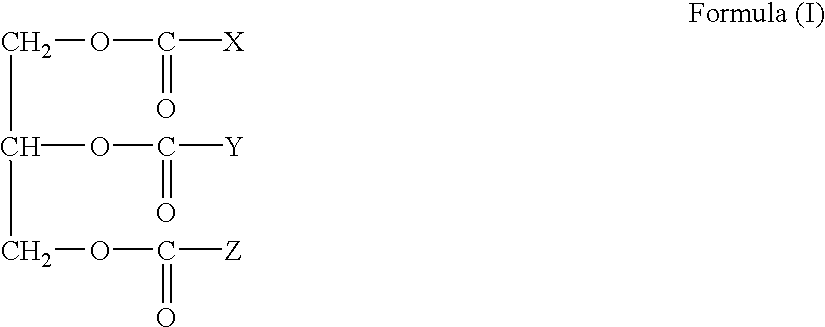Plant seed oils
a technology of plant seeds and seeds, applied in the field of plant seed oil, can solve the problems of not being able to meet the needs of difficult to effect a change which will not alter the fas in other tissues of the plant, and limited application of this techniqu
- Summary
- Abstract
- Description
- Claims
- Application Information
AI Technical Summary
Benefits of technology
Problems solved by technology
Method used
Image
Examples
example 1
Identification of Fatty Acid Modification Sequences
[0119] 1.1. Cell-Free Extracts
[0120] Cell-free extracts may be used to screen potential fatty acid modifying enzymes. One method is described in U.S. Pat. No. 5,147,792, issued Sep. 15, 1992, which is hereby incorporated by reference.
[0121] 1.2 Expression in E. coli
[0122] Once a putative fatty acid modifying DNA sequence is obtained, expression in E. coli may be desired to verify that the sequence does in fact encode for the desired enzyme activity. In some instances, the desired activity of the enzyme will be recognizable from a modified phenotype in the E. coli. In some instances, further analysis will be required, for example, addition to a cell-free extract as described in 1.1, to verify the enzyme.
example 2
Modified Fatty Acid Composition via Expression of a Foreign Plant Enzyme
[0123] 2.1. Modification of Fatty Acid Chain Length
[0124] 2.1.1. Produce C12:0--Bay MCFA
[0125] A DNA sequence encoding for Umbellularia californica, also known as "Bay," C12:0-ACP thioesterase is found in FIG. 5.
[0126] pCGN3816 (ATTC #), a napin 5' / thioesterase / napin 3' binary vector construct was prepared and used to transform Brassica napus plants in accordance with methods known in the art.
[0127] Seeds from Brassica napus plants transformed with pCGN3816 are analyzed for total fatty acids. Analysis of single segregating seeds from T2 transformed plants reveals levels of C12:0 ranging from zero to 14.5%, as compared to zero percent in seeds from untransformed control plants. C12:0 levels correlate to C12:0-ACP thioesterase activities in corresponding immature seeds. In addition, C14:0 is also detected in these seeds at levels correlating with those of the C12:0, although C14:0 levels are lower.
[0128] 2.1.2. Pr...
example 3
Modified Fatty Acid Composition via Expression of a Non-Plant Enzyme
[0180] 3.1. Modification of Chain Length
[0181] 3.1.1. Increase C14:0--Vibrio
[0182] Constructs for expression of the Vibrio harvei myristoyl ACP thioesterase in plant cells which utilize napin promoter regions are prepared as follows: Two 100 base oligos are synthesized:
9 HARV-S: (SEQ ID NO:22) 5'CGG TCT AGA TAA CAA TCA ATG CAA GAC TAT TGC ACA CGT GTT GCG TGT GAA CAA TGG TCA GGA GCT TCA CGT CTG GGA AAC GCC CCC AAA AGA AAA CGT G 3' HARV-A: (SEQ ID NO:23) 5'ATA CTC GGC CAA TCC AGC GAA GTG GTC CAT TCT TCT GGC GAA ACC AGA AGC AAT CAA AAT GGT GTT GTT TTT AAA AGG CAC GTT TTC TTT TGG GGG CGT T 3'
[0183] The two oligos contain 20 bp of complementary sequence for annealing. A TAQ polymerase extension reaction utilizing the two oligos yields a 180 bp product. The oligos consist essentially of luxD gene sequence with sequence changes introduced to remove 3 potential poly A addition sites and to alter 5 nucleotides to change the ...
PUM
| Property | Measurement | Unit |
|---|---|---|
| Temperature | aaaaa | aaaaa |
| Temperature | aaaaa | aaaaa |
| Temperature | aaaaa | aaaaa |
Abstract
Description
Claims
Application Information
 Login to View More
Login to View More - R&D
- Intellectual Property
- Life Sciences
- Materials
- Tech Scout
- Unparalleled Data Quality
- Higher Quality Content
- 60% Fewer Hallucinations
Browse by: Latest US Patents, China's latest patents, Technical Efficacy Thesaurus, Application Domain, Technology Topic, Popular Technical Reports.
© 2025 PatSnap. All rights reserved.Legal|Privacy policy|Modern Slavery Act Transparency Statement|Sitemap|About US| Contact US: help@patsnap.com



